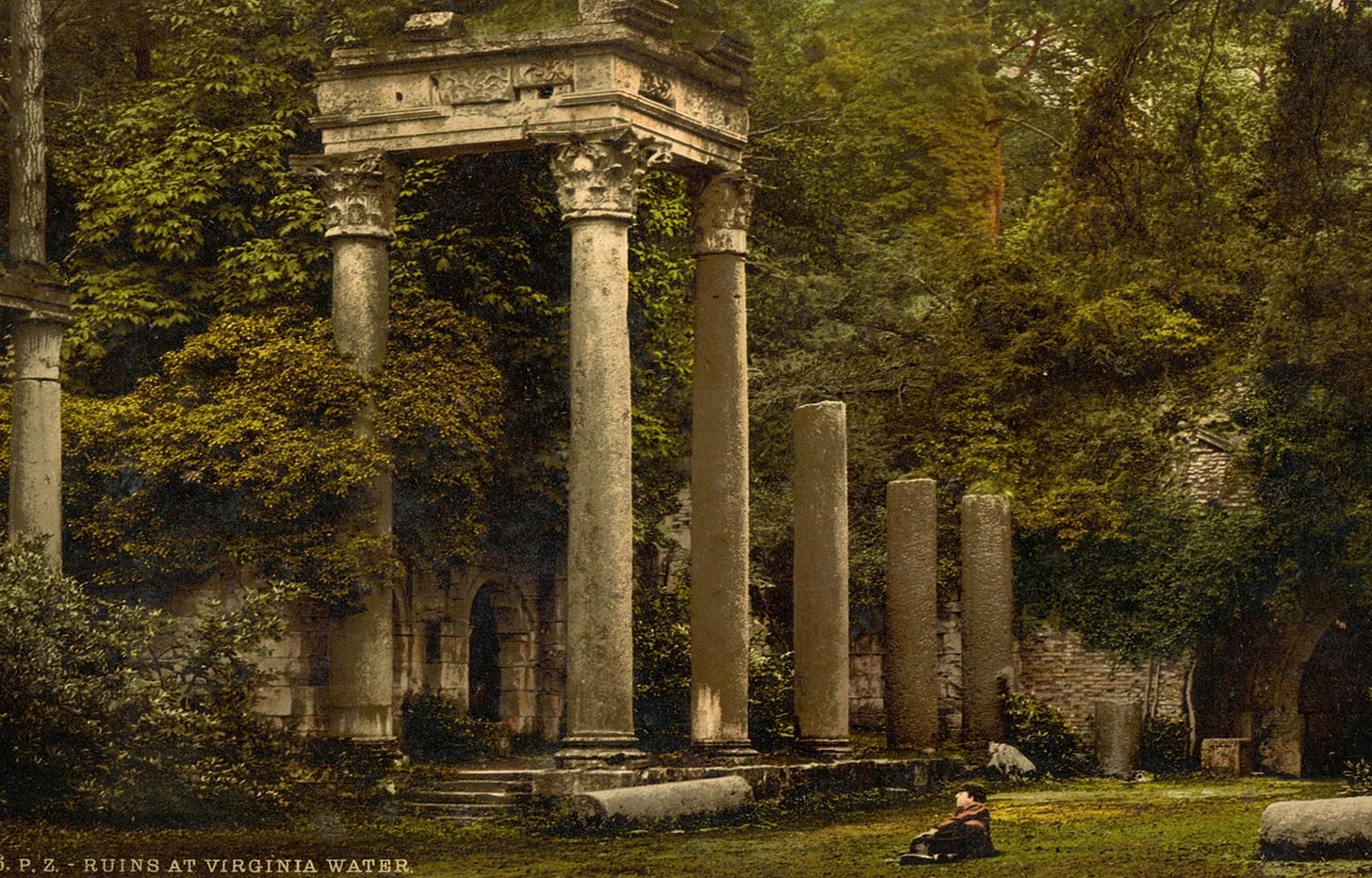The Machine Stops, Eventually
On Modernism's inability to age gracefully
Pre-modern architecture had the mysterious ability to age with grace. The layers of dust and the patina of time only added to its charm and aesthetic qualities.
The Romantics’ fascination with ruins was rooted in this realisation. Reacting to the forced industrialism of their age, they were attempting to aestheticise time itself; to feel more at home in decaying graveyards than in the crystal palaces of their age. To build new things that mimicked old ruins, only to linger in this twilight of nostalgia for what had been lost. Essentially, they were weaponising beauty against truth.
Yet their predecessors never built with Romantic intent. Greek temples were not designed to look good as white ruins; they were in fact full of saturated colours. So were the statues of Gothic cathedrals.
Pre-moderns never weaponised truth against beauty, nor beauty against truth. Rationality was not divorced from will; they were part of a cohesive whole. The reason why their buildings could age with grace tells us more about something we have lost in modernity than what ancient cultures had in common.
Fear of one’s own body
As John Rao once wrote, 'The best way to understand modernity is as a revolution against the Incarnation.' In other words, severing mind from body and proclaiming the primacy of detached reason.
In a paraphrase of The Abolition of Man, Auron MacIntyre describes the same process:
‘We will take this principle that is rooted in something concrete, remove its foundation—the truth that gave rise to it—then ask you to continue believing in it in a wholly abstract way. We will kill God and still ask you to remain gentle and loving. We will destroy biological fatherhood but still ask you to be loving parents to other people’s children. We will remove the organ, yet continue to demand the function’.
This weaponised abstraction then led to all sorts of polarisations, as what had once been parts of a coherent whole split into opposites competing for hegemony.
This is why the Romantic project, as noble and admirable as it undoubtedly was – had been rigged from the start, destined to a tragic fate. Weaponising beauty against reason - or body against head - could not reconstruct the whole.
Once our fedora’d post-Enlightenment predecessors became too self-aware in this disembodied way, they mistook their narrow cognition for absolute truth, denouncing the body they had severed from the head; cutting the branch they were sitting on. ‘In this moment, I am euphoric. Not because of any phony god's blessings. But because I am enlightened by my intelligence…’ (you know the thing).
In this twisted state, pain became the credential of truth. Only that which wounds you deserves your allegiance. This can easily turn sadistic and, in some ways, it already has.
Buildings that refuse to age
This also explains why contemporary architecture, in all its forms, exhibits this disdain for the body. Modern buildings shun ornament. They shun human proportions. They appear like scaleless sculptures, always denying people’s expectations of what buildings must look like; always attempting to deny or overcome gravity and tectonic logic. Where classical buildings emphasised solidity, modern ones appear as mysteriously floating. Where classical buildings emphasised symmetry and compositional coherence, modern ones emphasise confusion and ambiguity.
Another way in which contemporary architecture shuns the body is through industrialism – the slow march of removing craftsmanship through forced automation. What people refer to as ‘technology’ has come to signify only to this narrow drive for scripts and routines that automate away all traces of artisanship.
One of the unintended consequences of this slow selective filter is that natural materials themselves have been rejected in favour of new synthetic composites, plastics and aggregates. As Juhani Pallasmaa noticed:
Stone, brick and wood – allow our vision to penetrate their surfaces and enable us to become convinced of the veracity of matter. Natural materials express their age, as well as the story of their origins and their history of human use. All matter exists in the continuum of time; the patina of wear adds the enriching experience of time to the materials of construction – The Eyes of the Skin.
In other words, traditional architecture expressed its age because it was embodied. Contemporary architecture, like an adolescent in denial, rebels against everything Pallasmaa describes.
In its desire to transcend ageing, it hides its materiality and the veracity of matter. Noticed how all Modernist designs appear like weightless screens with no width and solidity?
In their desire to maintain youthful appearance, contemporary composites look appealing only for a brief window after inauguration, then start ageing terribly. Think of all the disgraceful 20-year old towers and the state of their aluminium cladding; their mirror-finished glass, now dulled by decades of dust. Think of the ‘honest’ exposed concrete monoliths ageing like post-apocalyptic Soviet factories.
None of these synthetic composites tell the story of their lab origins (if they did, who would even care about it?) nor their history of human use – since they didn’t have any. Even when economic incentives force people to work and spend time in these synthetic spaces, they fled them as soon as their work day was over. A walk through Canary Wharf after dusk is an uncanny experience: a cage emptied of its captives.
Nothing built like this can ever age gracefully, since the very mindset of Modernism is one contemptuous of the body - of its fragility, temporality and other perceived ‘shortcomings’.
Peak Modernism
Of all age groups, Baby Boomers appear to have internalised Modernist values most thoroughly. After the Summer of Love faded, many got caught in a kind of cultural denial of ageing. In much of the developed world, it’s not uncommon to see people well into their seventies resisting the markers of maturity - whether in dress, demeanour or broader responsibility. Later generations inherited this impulse, but the Boomer Kool-Aid seems to have peaked and may now be slowly receding.
This reversal of age dynamics has led to a peculiar historical condition: younger people, though often uncertain and overwhelmed, are increasingly the ones asking questions about heritage, posterity and long-term belonging. Meanwhile, many of their elders - shaped by decades of individualism and consumer culture - seem detached from such concerns. It’s not uncommon to hear dismissive refrains like “I’ll be long dead by then,” uttered out loud as if they’re meaningful arguments. How can anything endure when our elders show indifference or even quiet disdain toward questions of birth rates, factory-style childcare, abortion or even the very idea of their people’s future?
Yet the revolution against incarnation cannot last forever. We all age – gracefully or not – and time slows for no one. ‘The individual’ is not separate from his heritage nor his posterity.
The window for this social experiment is slowly closing, forcing us to act like adults once again. As soon as our collective attention shifts from the narrow present to the deep rhythm of civilisational time, our architecture will start to look completely different to what it is today. Ornament will make a comeback, natural materials will do so too and craftsmanship will become a necessity once again.









Europe still has good domestic architecture. The 3rd world cities are horribly modern all over with a very small traditional core.
Now, in addition to these excellent points, I wonder also about the interplay between the other branch of lost spirit in our time.
The defiance of gravity you describe, the exotic materials and so on of modern architecture seem by contrast quite appropriate for aircraft or sports cars, modern incarnations of chariots.
Much like Sauron's twisting of Numenorian technology into the hideous industry of the Orcs, I wonder if all driving spirits of our age might in their proper forms be noble and appropriate, hideous merely as a result of confusion about what their proper roles should be. The old masquerading as the young, the young psyopped into screen induced fear, utilitarian smallness and decrepitude.
Of course that masculine fire and ambition, the original brash selfish boldness of modern architecture (though this is now forgotten), looks out of place when applying itself to what should be the stable foundation of an age and a feminine connection to deep nature.